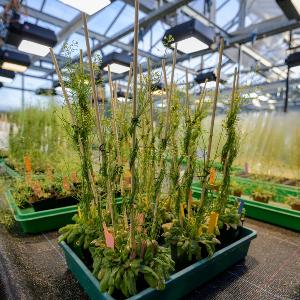Photosynthesis: auxiliary factor ensures efficient energy production
2 Nov 2022
LMU biologists demonstrate how the auxiliary factor CGL160 contributes to the synthesis of crucial parts of the photosynthetic machinery.
2 Nov 2022
LMU biologists demonstrate how the auxiliary factor CGL160 contributes to the synthesis of crucial parts of the photosynthetic machinery.

Working at the model: Arabidopsis thaliana in the greenhouse. | © LMU
Photosynthesis is the means by which plants, algae, and cyanobacteria extract their ‘food’ in the form of energy-rich biomolecules from sunlight, carbon dioxide, and water. It is a complex process, from which researchers are still coaxing many new details. A team led by LMU biologists Thilo Rühle, Bennet Reiter, and Prof. Dario Leister has now solved another piece of the puzzle of this essential process and elucidated the role of the auxiliary factor CGL160, as the scientists report in the journal The Plant Cell.
Photosynthesis takes place in several partial reactions at the so-called thylakoid membranes in the chloroplasts, where various pigments absorb the electromagnetic radiation of sunlight. Specific protein complexes in conjunction with ATP synthases then convert this light energy into chemical energy in the form of ATP. This enables the plant, among other things, to synthesize carbohydrates as energy-rich ‘fuel’ for cellular respiration. As ‘molecular machines,’ ATP synthases are therefore a vital component of plant metabolism.
How ATP synthases are assembled in the cell has not yet been fully clarified. Based on the model organism Arabidopsis thaliana, the researchers have now been able to demonstrate that the protein CGL160 plays a key role in the process by recruiting the coupling factor CF1 of the ATP synthase. “The protein CGL160 sits with its base in the thylakoid membrane, while its N-terminal domain protrudes like a rod and fishes the soluble CF1 portion of the ATP synthases out of the fluid inside the chloroplasts. This portion of the protein binds the CF1 ‘headpiece’ and facilitates linkage with the portion of the ATP synthase embedded in the thylakoid membrane, making its formation considerably more efficient,” explains Thilo Rühle.
Even under unfavorable growth conditions, the presence of auxiliary factors such as CGL160 prove to be advantageous: The LMU biologists discovered that an absence of CGL160, with its CF1-binding function, under conditions of light deficiency negatively impacts the development of chloroplasts. “We observed that the chloroplast structure of corresponding mutants suffers more during short days with just eight hours of daylight. We advance the hypothesis therefore that the interaction between the N-terminal domain of CGL160 and CF1 is also an evolutionary adaptation that enables plants to cope better in various light conditions,” says Rühle.
The researchers also found clues as to the evolutionary origin of CGL160. In experiments with Arabidopsis thaliana, they succeeded in functionally replacing the membrane domain of CGL160 with the Atp1 protein from cyanobacteria of the genus Synechocystis. “Around 80 percent of the function can be restored in this way. This suggests that CGL160 in land plants may have come from a predecessor protein of cyanobacteria,” says Rühle. Indeed, plant cells acquired their chloroplasts through incorporation and functional integration of cyanobacteria.
This set in train the emergence of a complex synthesis plan for photosynthetic machinery. To better understand this plan, the LMU biologists now want to identify all auxiliary factors – in addition to CGL160 and a handful of other currently known factors – that are important for the assembly and function of ATP synthases in plant thylakoid membranes. “We assume that there are much fewer factors involved here than in the photosystems themselves – accordingly, ATP synthase is an easier potential route for the regulation of photosynthesis,” says Rühle. “In the future, people could use this knowledge for various applications, such as modifying plants so that they can optimally cover their ATP requirements even when exposed to stressors like heat or extreme light conditions.”
Bennet Reiter, Lea Rosenhammer, Giada Marino, Stefan Geimer, Dario Leister, Thilo Rühle. CGL160-mediated recruitment of the coupling factor CF1 is required for efficient thylakoid ATP synthase assembly, photosynthesis, and chloroplast development in Arabidopsis. The Plant Cell, 2022.